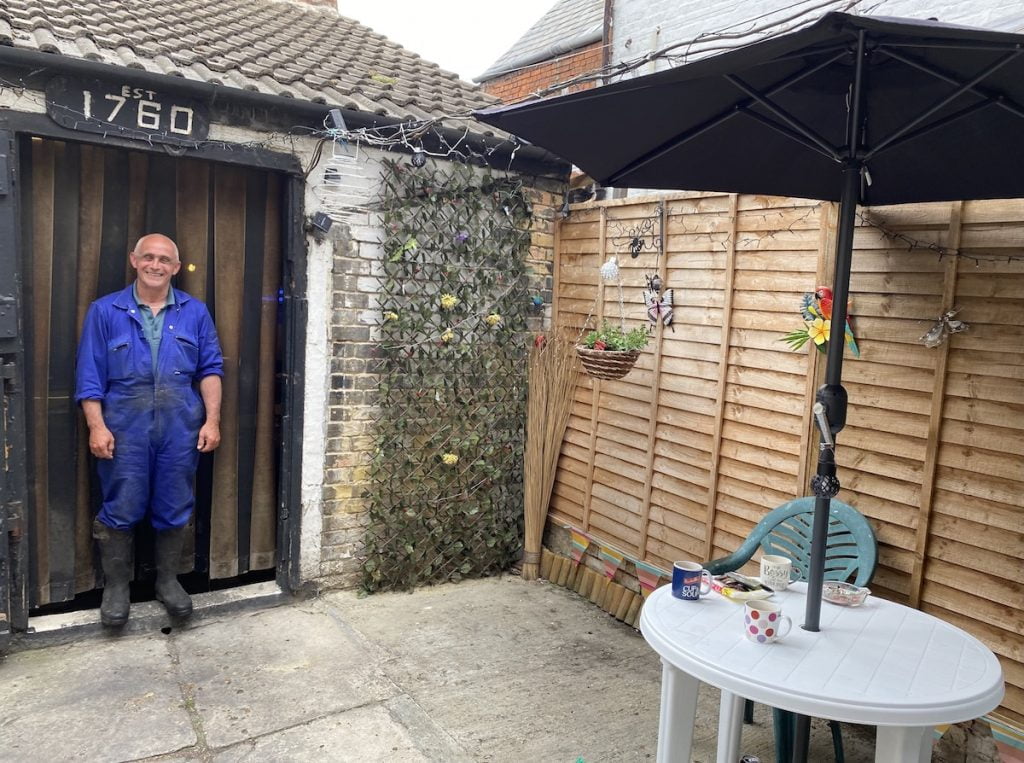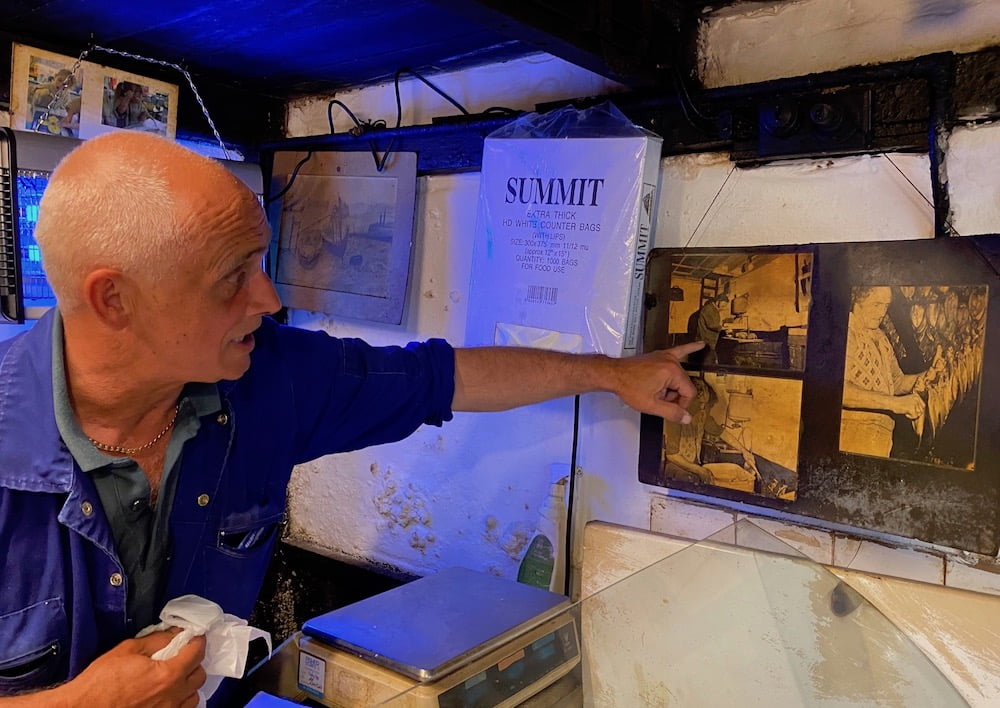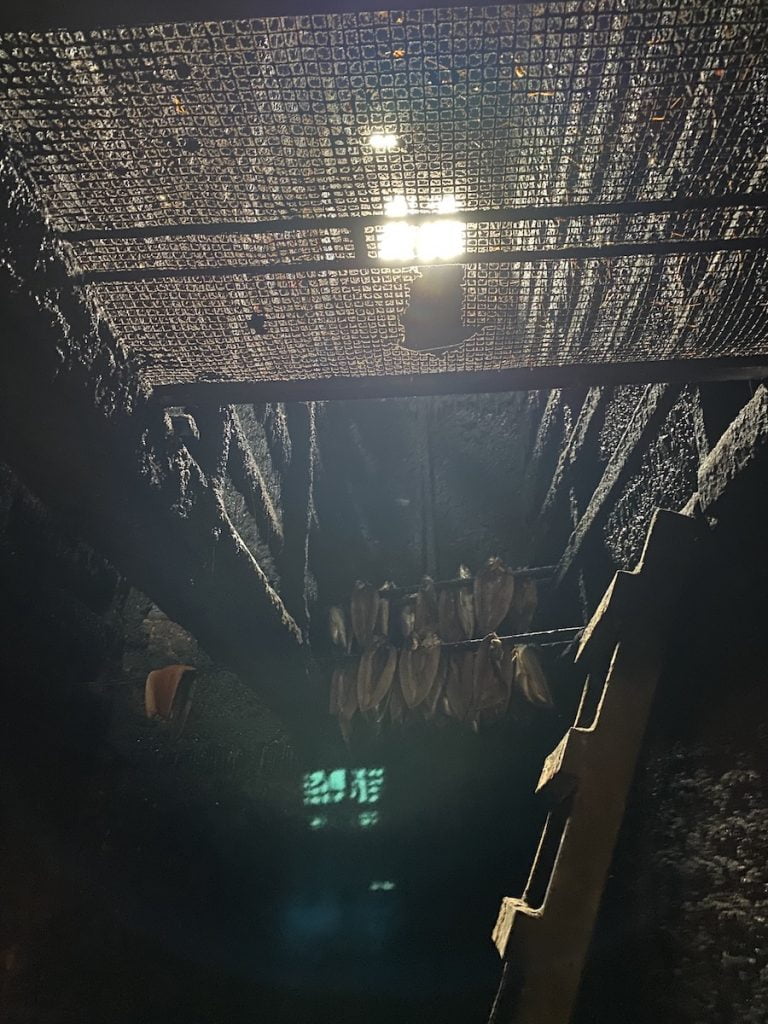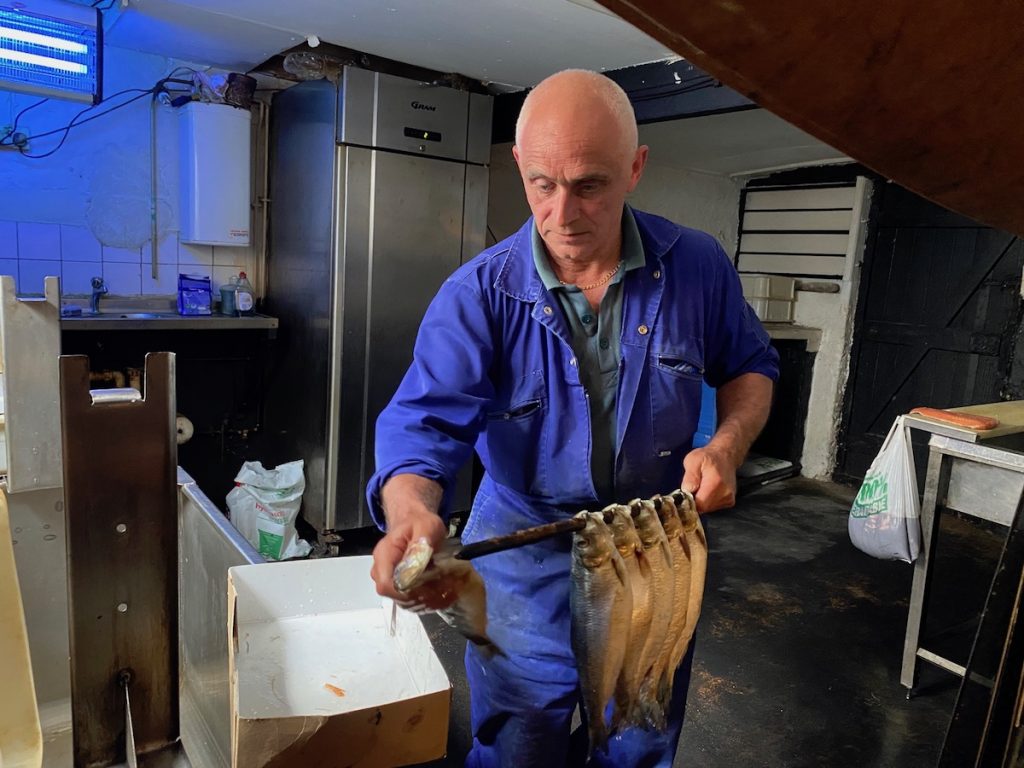One of the last red herring smokers, Will Buckenham in Lowestoft produces these, along with bloaters and kippers in the country’s oldest working smokehouse
SMOKEHOUSE TALES: WILL BUCKENHAM
The Old Smokehouse, Lowestoft
The herripedia has only been able to trace two smokehouses in the UK still producing red herring. Both of them are in Lowestoft, both are great and quite different from each other. The town is worth a pilgrimage...
I interviewed Will Buckenham at his smokehouse on Raglan Street. Dating from 1760, it’s, in fact, the oldest working one in the country: a rare example of a street corner smokehouse. Kippers, bloaters, smoked haddock and other fish are sold throughout the year, but his red herring and smoked sprats are seasonal.
I went in June, so I’m going to have to go back in January to sample his reds. If you want to try his wares – and on the basis of his kippers and bloaters, I’d recommend it – you have to go to Raglan Street, which is a couple of hundred yards from the railway station.
The other red herring producer is Waveney Valley Smokehouse, whose Gerry Skews I interviewed on the same trip.

The Story
Me dad was here before I was here.
He’d probably been here thirty… thirty five years himself. He passed away about fifteen or twenty year ago and I’ve been here ever since. So probably, me dad and meself have been doing it the best part of fifty years between us.
So I picked up everything what I needed to know off him, while he was going, ’cause he’d done smoking all his life, while I’ve only done it part of my life.
To start with, me dad used to work at a smokehouse up in Clapham Road and he’d probably done twenty five, thirty years up there as a smoker. His boss, who was in Norwich, she kept saying she was going to close it down and everything was uncertain. Me dad got offered this smokehouse, which is in Raglan Street, which had been empty for about two or three years, by Mr Donny Cole, who’d bought it off Reggie Reynolds.

The Reynoldses had been here for years and years and years, probably going back to the First World War. But, anyway, me dad come in here and rented it off the Coles for probably the best part of eighteen years. And Donny Cole asked me dad to buy it, so me dad said to me, if you were going to run it when he’d go, he’d buy it, which is exactly what he done. And when he passed away he left it to me from then, so that’s how I become to get it.
But the Reynoldses were here before we were all here and a lot of people still know it, even today as Reynolds’s Smokehouse. It hain’t been Reynolds’s for the best past of fifty years, but people don’t forget.
Red herring and tenterhooks
We still do the red herrin’, but to make a red herrin’, you can’t just use any herrin’ you want. That’s got to be an October, November herring.
October is when the fishin’ used to start in Lowestoft. We used to probably have a hundred ships or a hundred boats go out to catch herrin’ and that was the peak time. We used to make red herrin’ out of them herrin’, which was a full herrin’ and a local herrin’. And they were the best ones. It’s like an apple. You get keepin’ apples and you get non-keepin’ apples, well the red herrin’ were the keepers and you could make them into red herrin’, because it takes a long time to make a red herrin’.
So we do buy the herrin’ from October, November and they takes ten weeks to smoke, but what you’ve got to do first of all is salt them, heavily salt them. That’s where the word come in, rousin’ the herrin’, because they used to put them in big vats, years ago, and they used to go in there with a big shovel and turn them over and add more salt to them and after seventy two hours they used to get them all out, put them in the smokehouse and start smokin’ them: smoke them for about ten weeks before they were ready. They’d go in as a silver fish and come out as like a golden colour, so that’s the smoke got into them and then they’re preserved. You can keep them.
The old story was that Reggie Reynolds had some red herrin’ and he got called up to war an’ he left them in a coal bunker out in the garden here and he come back in five years, after the war had finished and he went to the coal bunker, he got them out of the coal bunker and he ate them. Whether that’s a true story or not, I do not know, but that was one of the stories of the red herrin’.
Many, many years ago, there was so many herrin’ comin’ into Lowestoft that they had to do something with them. It was a form of keeping them and selling them when the herrin’ was finished. A lot of people say they used to go to feed the crews on a boat when it was going away for a long time, because you could keep them an’ that. I couldn’t tell you, because I wasn’t about then, but that’s what different people tell you.
Of course, a lot of people think red herring’s not a real thing. Same as you hear of people bein’ on tenterhooks. Well, we use tenterhooks. It’s what we hang our kippers on. That’s what they are called: tenterhooks. Yeah. Yeah. It’s an actual word. It’s like they say, Oh, it’s a red herrin’. Well, red herrin’ is a red herrin’ and a tenterhook is a tenterhook. Yeah.
Kippers hang on balks. They’re long balks and they’ve got all little hooks in them and you hang your kippers on them, which are your tenterhooks. Bloaters we put on a wooden speat an’ haddocks go on a metal rod, which is a double and they go acrosst or otherwise they’d fall off.
I’ve never ever bought any tenterhooks, because we’re still got one or two here what we’re still usin’ if we need to replace ’em. I do believe you used to order ’em from Scotland.
But, yeah, the tenterhook is a real thing and so is a red herrin’.

Supplies and markets
You can still buy the herrin’ for as much as what we can sell. You can still buy what you want, in the right situation, as long as they’re there. Even going back fifty, sixty, seventy years ago, they used to have good years and bad years. Sometimes we have bad years here where you don’t get hardly any and then another year there’ll be as much as you want. I’ve even seen boats comin’ in now with probably thirty, forty, fifty, a hundred stone on ’em. Then you’d see another boat come in with about five stone on ’em. You just can’t tell what you’re going to get when you put your nets over.
You can’t rely on just local fish anymore, because we haven’t got no big vessels goin’ in and out of Lowestoft. So, if you just relied on the longshore, you’d probably have cod and plaice and a couple of other bits and pieces and that’d be all you had. That’s the reason why the fish merchants do bring stuff in from Grimsby… Hull… They bring it from everywhere by lorry to keep us going anyway.
If it wasn’t for them doing it, then obviously we wouldn’t have the variety of fish and you wouldn’t be able to get a livin’ and if you can’t get a livin’ you can’t be here. The kippers we make, the herrin’ we buy now come from Norway, ’cause the Norwegians have got a big fishin’ fleet still and they can supply everybody with the herrin’ they want and they have nice big ones and they can make really, really good kippers.
We do kippers, we do bloaters. In the right season, like in October, November we do cut the small herrin’ and we do bloater the small herrin’, because you can’t beat them, but, ’cause of the size of them, some people say, Oh I could eat twelve o’ them! Yeah, but they can’t eat twelve of the Norwegian ones, because they’re a lot, lot bigger. On the small herrin’ they could do, but they couldn’t eat twelve of the big ones.
They were the local herrin’. They’d start the season about the 10th, 11th of October, every year, and the fishing fleet used to go out and catch just, literally, herrin’ for the market here. A lot of them used to go away. The Scottish girls come down and put them in barrels, along the beach somewhere, used to put them in big barrels and salt them all down and they’d send them all to wherever they sent them to.
The Scottish girls used to follow the herrin’ down the coast from Scotland all the way down and round the country, wherever the herrin’ were next, each place.
A lot of the people who buy them are just locals. A lot of our trade do come from Norwich. A lot of people come from Norwich down to Lowestoft to get good quality smoked fish, kippers, red herrin’ when we’ve got ’em, because they know that’s better than what they can get in the city. And we get a lot of people from Felixtowe, places like that.
I’ve noticed over the years, you do a few less red herrin’ each year, because you only want to be sellin’ them for, say, six months after you’ve got ’em done. Sales of red herrin’ and kippers and bloaters have all dropped down over the years, because there’s too many takeaway shops, MacDonalds, too many convenience foods and people just don’t want the inconvenience of having to cook it.
Smoking
Goin’ back over the years, there was roughly two hundred and eighty of these in Lowestoft: smokehouses. There was virtually one on every street corner. That’s the volume of herrin’ what was comin’ in at the time. I ain’t gonna say they was all used all the time, ’cause obviously if you were followin’ the fish down, if you come from Scotland and you got smokers down, you’d probably just use all the herring were here and then you’d move somewhere else. But, yeah, there was two hundred and eighty of these. And, yeah, there’s now probably about, what? Proper ones, like what we call original, probably about two.
Nowadays, they bring in what we call as hot smoked, which we can’t do. That cooks the fish at the same time. We can’t do that. We’re still traditionally the cold smoke. We still end up with a product what you’ve got to cook at the end. Yeah. Yeah. Still a lot better, really.
Everything you do you have to use a brine. You can’t smoke anything without a brine. So when you buy your herrin’ in, you cut ’em to be kippers, which obviously, you stand and cut ’em all and open them up, scrape all the bone, wash ’em all through, then they go in a salt brine for about fifteen to twenty minutes. You then taken them out of there and they hang in the smokehouse for about, say, three or four hours and then you can light a fire up on them.
A traditional kipper fire is five pods, like a pyramid, and you put five pods down. You can be a mile long, as long as you do your fives all the way down: one, one, one in the middle, one, one, one in the middle… You could keep going for a mile long: dunt matter how long it is. The five fires is what you need for a traditional kipper fire.
The same as bloaters. We brine them for about four or five hours, just in salt, and then speat them up – what we call speats. We do them as the whole fish and the speat just go through the gills. Then you put them in the smokehouse and they stay for about four or five hours before you light the fires.
It just gives them the chance to drip dry a little bit, get some of the water off. If not, if you try to light them up too early, the water what’s drippin’ off everything will put the fires out. So you’ve got to let them drain a little bit, otherwise your fires’ll keep going out. I’ve had that problem before.

A kipper is done overnight. I’ll just light a fire about half past four and some days – or some mornin’s – you come back and there’s still a little bit of red ember left. So they smoke from half past four to, probably, seven o’clock, you know, constantly smokin’. An’ that does it. A bloater’ll take exactly the same time. You can put them in beside the kippers or underneath the kippers or above the kippers and they will smoke in the same time as it does to do a kipper.
The little sprat, when we smoke the sprats in the wintertime, they take two nights to smoke. Although they’re tiny, the smoke don’t go into them in one night, you have to give them two nights. You’d think, being a smaller fish, they’d be done in a matter of hours. No. They take us two nights. ‘Cause they’re like a miniature, if you like, of red herring. They’ll come out a nice an’ strong flavour and they’re really good, but we only do them in about November time.
We only do red herrin’ from season to season, so, obviously, if people buy ’em, they’re buyin’ ’em in that season. I wouldn’t really be keepin’ them any more than 6 or 7 months, meself, but the story what I got told from Reggie Reynolds, whether that was true or not, I don’t know. He’s not here to ask and that was always the talkin’ point, that Reggie went to this coal bunker, got his herrin’ out after 5 years and cooked ’em and ate ’em or just ate ’em.
The salt, that is where the problem is, because, years ago people never had fridges, people never had freezers, so your stuff what was salted, salt was like a preservative and you needed that to keep anything, where, nowadays you don’t need to salt, because you can buy ’em, take ’em home an’ freeze ’em. An’ that’s why you don’t need the salt and obviously people don’t want the salt in their own bodies like they used to anyway.
Salt, in our way, is not a preservative, not for kippers an’ that. It’s just a thing we have to do so we can smoke ’em. Yeah. Yeah. ‘Cause if you heavily salt, like a red herrin’, that’s preserved. That’s preserved. But with a kipper you only want so much salt in ’em, so you don’t need to freeze ’em. Because if you put a kipper or a bloater into a freezer, that do gain 1% more salt by freezin’ it. Yeah. I don’t know how a freezer can do that, but that’s what a freezer can do.
Years ago there’d have been two smokers here. You’d have had a day smoker and a nighttime smoker, because when you’d got a lot of the stuff in the house, you’d need to bring ’em down: bring the bottom layers all down and then bring all the top ones down and then re-lay another small fire, just to finish them top ones off, because the smoke’d be gettin’ a bit weaker as it go through the fish. Yeah. So, then you’d need two smokers, but now we just do it with one smoker, ’cause you ain’t got to go right to the very top like we used to. Yeah. There’s less demand, less herrin’ so therefore you haven’t got to do that.
Kippers by post
I can remember we used to have what we call as a swing bridge down here and there used to be a restaurant and a place on the corner, used to be called Fane’s. They used to be able to send kippers away from there. And when we were workin’ up at Harry Groom’s smokehouse, which was in Clapham Road, we used to send a hundred stone of kippers down there in a day and they’d be boxed in pairs and sent away.
That’s how many tourists we had here in them days. And they’d send them back to their relations all over the country. And then they’d be phonin’ up in the afternoon, Have you got any more kippers? ’cause they’d run out. That’s the quantities that you’d be able to do then. But not now.
We only serve to the general public, now…
Years ago, you used to have a good postal service and they would guarantee the next day delivery and that people would get the product the next day, which was no problem. But if you try to put kippers through the post today, somebody could get ’em tomorrow, they could get them next Wednesday, next Thursday. You just cannot guarantee on the postal service what we’ve got today to what you could goin’ back probably sixty or seventy years ago, when it was guaranteed.
In Yarmouth there used to be a shop on the corner, like Fane’s, where you could go in there and send a pair of kippers to your relations down in wherever they lived. I do believe Yarmouth kept their guarantee, kept their postal goin’ for quite a long time, up to two or three year ago, but they took Lowestoft’s away many, many years ago.
It’s all right sending something away and they get it first thing tomorrow mornin’. Fine. But you get a warm night or a hot night and that fish is layin’ in a sortin’ office somewhere, that ain’t goin’ to get there as good.
Eating reds
The way me dad always told me, what you do with them is you simmer ’em in water, plain water for about six minutes and then you tip the water off and you put the red herrin’ on to your plate and have it with a little bit of English mustard and that kills the salt. And you can’t beat ’em for the flavour.
I’ve got one or two friends who come in an’ they tell me they slice theirs up and eat ’em as they are, because obviously they’ve been well smoked, they’ve been heavily salted. They just cut the skin off and eat the flesh. Yeah.
But I was always told by me dad to simmer ’em in water. That just helps take some of the salt out and put some of the moisture back into ’em, because by smokin’ them all that time, they are dry. Just simmer ’em in the water an’ that usually do the trick, and a little bit of English mustard with ’em. Yeah.
But, if you want red herrin’ from here, you’ve got to bear in mind, when we smoke ’em in October, they take us ten weeks. Christmas is very busy and before Christmas is very busy, but in January, every year, whatever business you’re in, it’s a slow time an’ there’s not a lot of money about, because people spent it over Christmas, which is fair do’s.
What we try and do is hold on to our red herrin’ for when we come back after Christmas, because that brings people in, so we get some more money comin’ in and that keeps us. January is the best time. We can hold on to them roughly to about Eastertime. We do enough to last us till about Eastertime and then they’re usually gone.
Obviously we still keep on with the kippers an’ bloaters an’ stuff all through the year.
Contact
The Old Smokehouse produces kippers, bloaters, red herring, smoked sprats and smoked haddock, as well as selling other fish from its shop.
The Old Smokehouse, 37 Raglan Street, Lowestoft, NR32 2JP.
Tel: +44 1502 581929
See also
- BLACK HERRING
- BLOATER
- BRITISH FISHERY
- BRITTEN
- BUCKLING
- DRIED HERRING
- DRIFT OR GILL NETTING
- FASTING
- FLEAS
- GOLDEN HERRING
- GREEN HERRING
- HARENG SAUR
- HARENG SAUR MONOLOGUES
- KIPPER
- MONKEY BUSINESS
- MUIR, JIM (HERRING INTERVIEW, ACHILTIBUIE)
- NASHES LENTEN STUFFE
- PICKELHERING
- RED HERRING
- RED HERRING JOKE, THE
- ROLLMOPS & BISMARCKS
- SALT
- SCHMALTZ HERRING
- SHOALS
- SHOALS OF HERRING, THE
- SILVER HERRING
- SINGING THE FISHING
- SUFFERING SALTWORKERS OF SHIELDS
- SURSTRÖMMING
- WHITE HERRING
- WITCHCRAFT
